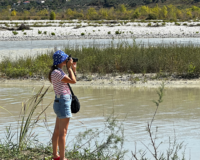By Skenderi
A group of environmental experts of 9 people with scientific titles have made an independent expertise whether the environmental permit granted in 2013 for the construction of two HPPs in Dragobi was based on scientific arguments.
This recent expertise provided by Dr. Abdulla Diku, Prof. Dr. Anila Paparisto, Prof. Dr. Aleko Miho Dr. Ermelinda Mahmutaj, Prof. Dr. Ferdinand Bego, Prof. Dr. Lulezim Shuka, Msc. Olsi Nika, Prof. Dr. Petrit Hoda and Prof. Dr. Spase Shumka concludes that the environmental permit for the two hydropower plants of the first contract in Dragobi contains many deficiencies and conclusions with serious flaws in the environmental study.

Based on expert reviews of fields including ecology, flora and vegetation, fauna, landscape, social and ethical aspects, the study found that the impact of the two hydropower plants in the Dragobia Cascade on terrestrial and aquatic flora and fauna is strong.
Meanwhile, it is noted that there were serious flaws in the methodology and structure of the Environmental Impact Assessment (EIA), such as a general lack of assessment of impacts, superficial analysis of mitigation measures (affected by the lack of data), superficial analysis ( even lack) of the impacts of diversions and reduction of water flow on freshwater biodiversity and habitats for ca.
9 independent experts have found in the environmental impact assessment the lack of integrated approach of ecosystems, the lack of interdisciplinary analysis, the complete lack of ecological, floristic and faunal components, the dominance of the engineering and hydrological approach, the poverty of the methodological elements of the approach, the lack of other alternatives to the construction of hydropower plants and the poor approach of impact assessment and mitigation measures.
Based on these findings, the independent environmental experts believe that the assessment presented in the report does not provide any real possibility of a general understanding of the environmental and socio-economic impacts that the intervention in the Dragobia cascade may cause.
They state that this is a typical example where the “scheme” represents a penalty for biodiversity, nature and society, and a relatively common example of “greedy hydropower development”, when engineers try to exploit high percentages of hydropower potential (let say > 90%) and thus endanger and neglect all other values of the natural ecosystem of our rivers.
“We think that there are other, less destructive options, but only if the assessments of ecosystem services (in addition to the use of hydropower potential) are carried out in a scientific way, leaving room for the maintenance of important ecological services for living things and society” say independent experts .
The Environmental Impact Decision for the two Dragobia hydropower plants was drawn up in June 2013, and the Environmental Permit from KTA was issued on July 23, 2013, valid for only 2 years. The permit states that it can be repeated or canceled when previously unknown ecological elements appear, as in this case.
“It is for this reason that we hope that all these are reasons for the Government to restart the issue of the construction of these HPPs” says the group of experts.
The experts’ report says that the diversion of water through tunnels and the reduction of the amount of water in the river bed will be accompanied by irreparable environmental consequences. The document lacks logical analyses.
Water flow is a major determinant of the physical environment in rivers and streams, which in turn is a major determinant of biotic composition.
The knowledge of EIA expertise related to nature protection, ecotourism and sustainable development is very limited.
You can find the article published by 27.al here (in Albanian).







